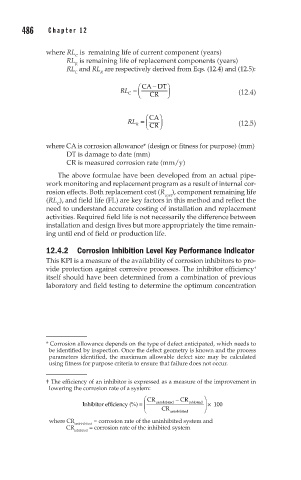Page 519 - Corrosion Engineering Principles and Practice
P. 519
486 C h a p t e r 1 2 C o r r o s i o n a s a R i s k 487
where RL is remaining life of current component (years)
C
RL is remaining life of replacement components (years)
R
RL and RL are respectively derived from Eqs. (12.4) and (12.5):
C R
CA − DT
RL = CR (12.4)
C
CA
RL = CR (12.5)
R
where CA is corrosion allowance* (design or fitness for purpose) (mm)
DT is damage to date (mm)
CR is measured corrosion rate (mm/y)
The above formulae have been developed from an actual pipe-
work monitoring and replacement program as a result of internal cor-
rosion effects. Both replacement cost (R cost ), component remaining life
(RL ), and field life (FL) are key factors in this method and reflect the
C
need to understand accurate costing of installation and replacement
activities. Required field life is not necessarily the difference between
installation and design lives but more appropriately the time remain-
ing until end of field or production life.
12.4.2 Corrosion Inhibition Level Key Performance Indicator
This KPI is a measure of the availability of corrosion inhibitors to pro-
vide protection against corrosive processes. The inhibitor efficiency
†
itself should have been determined from a combination of previous
laboratory and field testing to determine the optimum concentration
* Corrosion allowance depends on the type of defect anticipated, which needs to
be identified by inspection. Once the defect geometry is known and the process
parameters identified, the maximum allowable defect size may be calculated
using fitness for purpose criteria to ensure that failure does not occur.
† The efficiency of an inhibitor is expressed as a measure of the improvement in
lowering the corrosion rate of a system:
CR − CR
h
Inhibitor efficiency (%) = uninhibited inhibited × 100
CR uninhibited
where CR uninhibited = corrosion rate of the uninhibited system and
CR = corrosion rate of the inhibited system
inhibited

